Chai Spices
We make our chai using real spices and not spice "flavours". For our Authentic chai blends we use whole spices and for our instant chai we used ground spices. We pride ourselves on making our delicious drinks from spices without the use of tea. Please see below for some information on the spices we use in our mixes.
Bay leaves

Bay or bay laurel or sweet bay is native to Asia Minor and the Mediterranean region in general - it is a small evergreen shrub or tree. The early Greeks and Romans admired the bay laurel for its beauty and used the aromatic leaves in many different ways. Bay laurel possesses leathery leaves that are lanceolate and pointed in shape. The leaves also have the maximum oil content during early and mid-summer and this oil content tends to decreases in other seasons. The name “bay” is used to refer to several botanicals - for example the West Indian bay - botanical name Pimenta racemosa, and the California bay - botanical name Umbellularia californica. Therefore, any of these plants can be called by the name “bay” in the existing herb literature; what is more, some other plants are also called ‘Bay’.
Remedies made from the bay laurel are mainly used in the treatment of the disorders affecting the upper digestive tract and to ease all kinds of arthritic aches and pains affecting a person. The remedies made from the bay laurel also has a tonic effect and is good to have a settling effect on the stomach, the bay laurel remedy also stimulates general appetite and aids in the hastening the secretion of digestive juices in people with digestive disorders. The bay laurel leaves are also used as an ingredient in cooking, where they aid in the process of digestion and absorption of food in the stomach. Bay laurel leaves possess many of the same positive effects as seen in the spearmint - botanical name Mentha spicata, and the rosemary - Rosmarinus officinalis - especially in assisting in the breakdown of heavy foods, such as protein rich meat. The onset of menstruation is also promoted by remedies made from the bay laurel. In addition, the essential oil obtained from the bay laurel is mainly employed as a friction rub for topical problems, this rubbing oil is prepared by first diluting the raw oil in carrier oil and it is then massaged on aching muscles and joints for a soothing effect. Bath water can also be infused with a decoction made from the bay laurel leaves to help ease aching limbs and muscles.
Remedies made from the bay laurel are mainly used in the treatment of the disorders affecting the upper digestive tract and to ease all kinds of arthritic aches and pains affecting a person. The remedies made from the bay laurel also has a tonic effect and is good to have a settling effect on the stomach, the bay laurel remedy also stimulates general appetite and aids in the hastening the secretion of digestive juices in people with digestive disorders. The bay laurel leaves are also used as an ingredient in cooking, where they aid in the process of digestion and absorption of food in the stomach. Bay laurel leaves possess many of the same positive effects as seen in the spearmint - botanical name Mentha spicata, and the rosemary - Rosmarinus officinalis - especially in assisting in the breakdown of heavy foods, such as protein rich meat. The onset of menstruation is also promoted by remedies made from the bay laurel. In addition, the essential oil obtained from the bay laurel is mainly employed as a friction rub for topical problems, this rubbing oil is prepared by first diluting the raw oil in carrier oil and it is then massaged on aching muscles and joints for a soothing effect. Bath water can also be infused with a decoction made from the bay laurel leaves to help ease aching limbs and muscles.
Black Pepper

Black pepper is a well known spice around the world and is used in almost every home, this herb is native to southern India, though it is now cultivated widely in many tropical countries of the world.
The plant itself is a perennial woody climbing vine which can reach a height of about 15 ft or 5 meters climbing on trees and along man made wooden trellises.
Commercial pepper itself is made from the many clusters of small round fruits borne on the plant, these small fruits are the pepper of common use, and these fruits ripen from a green to red coloration as they mature on the vine.
The stimulating effect of the black pepper on the human digestive tract and circulatory system can be inferred from its familiar sharp taste, it can be used as a stimulant. Used by itself or as a part of some herbal remedies in combination with other well known herbs and spices, the black pepper is often used to warm the body, and to help in improving the performance of the digestive system, by stimulating its functioning.
The plant itself is a perennial woody climbing vine which can reach a height of about 15 ft or 5 meters climbing on trees and along man made wooden trellises.
Commercial pepper itself is made from the many clusters of small round fruits borne on the plant, these small fruits are the pepper of common use, and these fruits ripen from a green to red coloration as they mature on the vine.
The stimulating effect of the black pepper on the human digestive tract and circulatory system can be inferred from its familiar sharp taste, it can be used as a stimulant. Used by itself or as a part of some herbal remedies in combination with other well known herbs and spices, the black pepper is often used to warm the body, and to help in improving the performance of the digestive system, by stimulating its functioning.
Cardamom

The plant called the cardamom is a very famous spice. This plant is one of the oldest known spices in the world. The ancient Egyptians made extensive use of the cardamom in the manufacture of perfumes and cosmetics. However, the use of the cardamom as an herbal medicine is not as well known as its use in culinary and cosmetic preparations. In the Indian system of medication known as Ayurvedic medicine, cardamom is utilized in the preparations of many remedies. The cardamom has been used for thousands of years in India as a medicine mainly employed as an excellent remedy for the treatment of many different digestive problems, particularly to help soothe indigestion and excess abdominal gas. The pungent and aromatic taste of the cardamom ensures that it combines well with other useful herbs in the preparation of herbal medicine.
The cardamom was one of the most valued spices of the ancient world and it was one of the principal items of trade. The ancient Greeks around the 4th century B.C highly valued the cardamom as a culinary spice and as a base for herbal medicines. Trade in cardamom was an important part of the trade links between the India and the Mediterranean region.
The Indians have used the cardamom in herbal medications since ancient times for treating various conditions, these problems include disorders such as asthma, chronic bronchitis, problems like kidney stones, disorders such as anorexia, debility, and a weakened vata. Indians also use the cardamom extensively as a spice; it is used as a flavoring in many delicious Indian foods.
The cardamom was one of the most valued spices of the ancient world and it was one of the principal items of trade. The ancient Greeks around the 4th century B.C highly valued the cardamom as a culinary spice and as a base for herbal medicines. Trade in cardamom was an important part of the trade links between the India and the Mediterranean region.
The Indians have used the cardamom in herbal medications since ancient times for treating various conditions, these problems include disorders such as asthma, chronic bronchitis, problems like kidney stones, disorders such as anorexia, debility, and a weakened vata. Indians also use the cardamom extensively as a spice; it is used as a flavoring in many delicious Indian foods.
Chilli
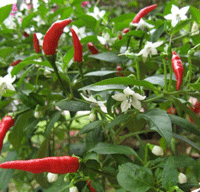
The capsicum (Chilli Pepper) plant is indigenous to South America, where they grow wild. The very first concerted cultivation of the plant is believed to have taken place around 7000 to 6000 BC and traces have been found at prehistoric burial sites around Peru. By the turn of the 15th century, when the Spanish and Portuguese discovered South America, chilli peppers were widely cultivated for human consumption.
The Spaniards found that drying and crushing the pods of the hottest chilli peppers, made an excellent fiery substitute for the peppercorn that was so extensively used in European cuisine. They named their fantastic discovery "pimienta" (which is the Spanish word for pepper), or "pimienta chilli" (as the Mexicans referred to them) so as to distinguish them from peppercorns. Soon enough, tons of chillis were being shipped back to Spain each year, much to the delight of the Spanish population.
It is interesting that the chilli is most popular in tropical climates. One half expects people living in these regions would avoid any more heat at all costs, but no, the stimulation of the hot chilli causes the heart to beat faster thus causing the body to sweat and since the sweat glands are the body's natural air conditioner, the tropics are obviously the place to activate them.
Chilli peppers, used with discretion, will also help a sluggish digestion. They certainly help the Mexicans and South Americans digest their heavy spicy foods. Most doctors in the 20th century agree that eating chilli, particularly the acrid Capsicum annuum frutescens, will encourage salivations, gastric secretions and gut movement and thus make food easier to digest. There is a West Indian recipe called Mandram which is also meant to help a weak digestion: chilli pods are mixed with thinly sliced, unpeeled cucumber, shallots, chives or onions, lemon or lime juice and Madeira. Similar recipes appear in homeopathic and herbal medicine books.
The Spaniards found that drying and crushing the pods of the hottest chilli peppers, made an excellent fiery substitute for the peppercorn that was so extensively used in European cuisine. They named their fantastic discovery "pimienta" (which is the Spanish word for pepper), or "pimienta chilli" (as the Mexicans referred to them) so as to distinguish them from peppercorns. Soon enough, tons of chillis were being shipped back to Spain each year, much to the delight of the Spanish population.
It is interesting that the chilli is most popular in tropical climates. One half expects people living in these regions would avoid any more heat at all costs, but no, the stimulation of the hot chilli causes the heart to beat faster thus causing the body to sweat and since the sweat glands are the body's natural air conditioner, the tropics are obviously the place to activate them.
Chilli peppers, used with discretion, will also help a sluggish digestion. They certainly help the Mexicans and South Americans digest their heavy spicy foods. Most doctors in the 20th century agree that eating chilli, particularly the acrid Capsicum annuum frutescens, will encourage salivations, gastric secretions and gut movement and thus make food easier to digest. There is a West Indian recipe called Mandram which is also meant to help a weak digestion: chilli pods are mixed with thinly sliced, unpeeled cucumber, shallots, chives or onions, lemon or lime juice and Madeira. Similar recipes appear in homeopathic and herbal medicine books.
Cinnamon
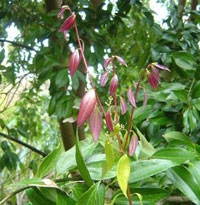
The plant known as the cinnamon is the source of a very famous spice, true cinnamon plants are native to Sri Lanka and Ceylon, while the plant called the cassia or the Chinese cinnamon originates from Burma - the bark of the cinnamon is fragrant and is used to make the spice. True Ceylonese cinnamon is much more expensive than the cassia, and has a lighter and more delicate fragrance; the Burmese variety is much more pungent and possesses a stronger flavor than the original cinnamon.
The traditional uses of the cinnamon go back a long time, and the herb was included by Moses as a major ingredient in the "holy anointing oil", he used to anoint his people.
Cinnamon is delicious and aromatic spice that is used as an effective and wonderful warming or strength boosting remedy to increase resistance to common cold, to beat back the winter chills and in the treatment of a variety of physical conditions associated with the common cold, it is also used in the treatment of internal congestion and in treating the deficiency in vital energy felt by the affected person. The whole system can be treated by using cinnamon as a general tonic in the treatment of many disorders affecting a person at the physical level.
The traditional uses of the cinnamon go back a long time, and the herb was included by Moses as a major ingredient in the "holy anointing oil", he used to anoint his people.
Cinnamon is delicious and aromatic spice that is used as an effective and wonderful warming or strength boosting remedy to increase resistance to common cold, to beat back the winter chills and in the treatment of a variety of physical conditions associated with the common cold, it is also used in the treatment of internal congestion and in treating the deficiency in vital energy felt by the affected person. The whole system can be treated by using cinnamon as a general tonic in the treatment of many disorders affecting a person at the physical level.
Cloves
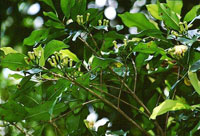
The association of the clove with human society is old indeed. The ancient Chinese Han dynasty - lasting from 207 B.C. to A.D. 220, gives us our first clue to the uses of the fragrant clove. Chinese physicians of that era wrote that the court visitors to the emperor were required to hold cloves in their mouths, while they addressed the emperor, it would be reasonable to believe that this was to save the ruler from the bad breath of the visitors.
The clove is a pungent and aromatic floral bud, and its use as a spice reached Europe around the 4th century A.D., when commercial trading really started with the Arabs who in turn acquired these dried and fragrant buds from the cultures to the east in Asia. The spice trade leading to great competition among European seafaring nations would also include trade in cloves, regarded as a precious spice aside from other equally prized spices such as peppers.
Since very ancient times, cultures in south eastern Asia have been using cloves for the preparation of many herbal remedies; tradition in these parts holds the cloves as almost a panacea for many illnesses. The tradition of using cloves in remedies goes back thousand of years in these parts of the world.
The folk and traditional medicine of many Asian cultures gave a high value to the clove, the herb is believed to have strong antiseptic and analgesic qualities, and it is treated as an herbal anodyne for all manner of illnesses in many cultures around the world. The clove oil especially has been used by traditional folk healers down the ages, as well as by modern pharmacists and dentists in alleviating the symptoms associated with toothache and dental decay. Clove herbal tea is another remedy which is recorded in the herbal literature of many Asian cultures, this tea is seen as a cure for problems such as nausea and as an aid to eliminating excess gas in the stomach and the intestines, and the clove herbal tea is prepared by boiling and steeping the dried clove buds in water. Disorders such as diarrhea and a hernia are treated in the Chinese system of medicine by giving the patient clove oil. All pathogenicfungi and other troublesome fungal infections such as athlete's foot can be treated using the tincture of clove oil, which is strongly fungicidal.
The clove is a pungent and aromatic floral bud, and its use as a spice reached Europe around the 4th century A.D., when commercial trading really started with the Arabs who in turn acquired these dried and fragrant buds from the cultures to the east in Asia. The spice trade leading to great competition among European seafaring nations would also include trade in cloves, regarded as a precious spice aside from other equally prized spices such as peppers.
Since very ancient times, cultures in south eastern Asia have been using cloves for the preparation of many herbal remedies; tradition in these parts holds the cloves as almost a panacea for many illnesses. The tradition of using cloves in remedies goes back thousand of years in these parts of the world.
The folk and traditional medicine of many Asian cultures gave a high value to the clove, the herb is believed to have strong antiseptic and analgesic qualities, and it is treated as an herbal anodyne for all manner of illnesses in many cultures around the world. The clove oil especially has been used by traditional folk healers down the ages, as well as by modern pharmacists and dentists in alleviating the symptoms associated with toothache and dental decay. Clove herbal tea is another remedy which is recorded in the herbal literature of many Asian cultures, this tea is seen as a cure for problems such as nausea and as an aid to eliminating excess gas in the stomach and the intestines, and the clove herbal tea is prepared by boiling and steeping the dried clove buds in water. Disorders such as diarrhea and a hernia are treated in the Chinese system of medicine by giving the patient clove oil. All pathogenicfungi and other troublesome fungal infections such as athlete's foot can be treated using the tincture of clove oil, which is strongly fungicidal.
Ginger
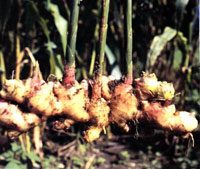
Zingiber officinale, the official name of the common ginger was coined by the famous eighteenth-century Swedish botanist and general naturalist, Carl Linnaeus. While Latinizing the name, Carl Linnaeus also derived the name Zingiber for the generic term, using the Indian Sanskrit name for ginger - singabera, or shaped like a horn.
About 1,400 species of plants are placed in the family Zingiberaceae and the ginger is just another of these plants. It shares equal honors with other famous family members, the spices turmeric - which is a principal component used in curry; it is also an herbal medicine - and the spice cardamom - used extensively in South Asian cuisine. The ginger has a slender stem; ginger is a perennial plant, about 24 to 39 inches in height. Compared to the second and following stems, the first stems are lengthier and also bear beautiful and fragrant flowers. The ginger flowers are greenish yellow and streaked with purple down the sides. Dark green ginger leaves are characterized by a famous midrib that is sheathed at the growing base. The seeds of the ginger appear in the rare fruiting body.
One of the main benefits of the herbal ginger remedy is its ability to stimulate the circulatory system. The herb also helps in bringing an increased flow of blood to the surface of the skin; this singular property makes the ginger a very important herbal remedy for the treatment of conditions such as chilblains and to treat impaired circulation along the hands and feet of patients. The herb also effectively helps in controlling elevated or high blood pressure as it directly affects the circulation of blood. Perspiration in the body is increased by remedies made from the ginger and at the same time, the herb helps in bringing about a reduction in elevated body temperature during fevers.
Herbal remedies made from the ginger have a warming and soothing effect and help alleviate persistent coughs, all kinds of colds and flu, and other related problems of the respiratory system.
About 1,400 species of plants are placed in the family Zingiberaceae and the ginger is just another of these plants. It shares equal honors with other famous family members, the spices turmeric - which is a principal component used in curry; it is also an herbal medicine - and the spice cardamom - used extensively in South Asian cuisine. The ginger has a slender stem; ginger is a perennial plant, about 24 to 39 inches in height. Compared to the second and following stems, the first stems are lengthier and also bear beautiful and fragrant flowers. The ginger flowers are greenish yellow and streaked with purple down the sides. Dark green ginger leaves are characterized by a famous midrib that is sheathed at the growing base. The seeds of the ginger appear in the rare fruiting body.
One of the main benefits of the herbal ginger remedy is its ability to stimulate the circulatory system. The herb also helps in bringing an increased flow of blood to the surface of the skin; this singular property makes the ginger a very important herbal remedy for the treatment of conditions such as chilblains and to treat impaired circulation along the hands and feet of patients. The herb also effectively helps in controlling elevated or high blood pressure as it directly affects the circulation of blood. Perspiration in the body is increased by remedies made from the ginger and at the same time, the herb helps in bringing about a reduction in elevated body temperature during fevers.
Herbal remedies made from the ginger have a warming and soothing effect and help alleviate persistent coughs, all kinds of colds and flu, and other related problems of the respiratory system.
Nutmeg
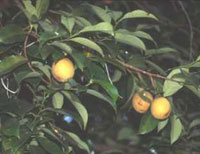
Nutmeg and mace both come from the nutmeg tree and have very similar medicinal properties; long been valued as an aphrodisiac and as a remedy for eczema and rheumatism.
The fruit of the nutmeg tree is fleshy like an apricot and about 2-4 inches in length. Upon ripening, it splits in half, exposing a bright-red, netlike aril wrapped around a dark reddish-brown and brittle shell within which lies a single seed. The net-like aril is mace, which on drying turns from red to yellowish or orange brown. The dried brown seed, after the shell is broken and discarded, is nutmeg.
Digestive problems - Nutmeg essential oil has an anesthetic and stimulating effect on the stomach and intestines, increasing appetite and reducing nausea, vomiting and diarrhea. It is a helpful remedy for many digestive problems, especially gastroenteritis.
Chinese medicine - In China, nutmeg is used specifically for diarrhea, helping to bind and warm the intestines and relieve abdominal pain and distension due to "cold."
Aphrodisiac - In India, nutmeg has a long reputation as an aphrodisiac. Nutmeg is believed to increase sexual stamina.
External uses - Ointments based on the fixed oil (nutmeg butter) are used to treat rheumatic conditions. They have a counterirritant effect, stimulating blood flow to the area. In India, nutmeg is ground into a paste and applied directly to areas of eczema and ringworm.
Safety - Low medicinal doses and culinary amounts of nutmeg and mace are safe. In excess, however, the herbs are strongly stimulant, hallucinogenic, and toxic. The consumption of just 2 whole nutmegs has been known to cause death .Myristicin is the constituent most responsible for this toxicity, and it is also hallucinogenic. In addition, safrole in isolation and at a high dosage is carcinogenic.
The fruit of the nutmeg tree is fleshy like an apricot and about 2-4 inches in length. Upon ripening, it splits in half, exposing a bright-red, netlike aril wrapped around a dark reddish-brown and brittle shell within which lies a single seed. The net-like aril is mace, which on drying turns from red to yellowish or orange brown. The dried brown seed, after the shell is broken and discarded, is nutmeg.
Digestive problems - Nutmeg essential oil has an anesthetic and stimulating effect on the stomach and intestines, increasing appetite and reducing nausea, vomiting and diarrhea. It is a helpful remedy for many digestive problems, especially gastroenteritis.
Chinese medicine - In China, nutmeg is used specifically for diarrhea, helping to bind and warm the intestines and relieve abdominal pain and distension due to "cold."
Aphrodisiac - In India, nutmeg has a long reputation as an aphrodisiac. Nutmeg is believed to increase sexual stamina.
External uses - Ointments based on the fixed oil (nutmeg butter) are used to treat rheumatic conditions. They have a counterirritant effect, stimulating blood flow to the area. In India, nutmeg is ground into a paste and applied directly to areas of eczema and ringworm.
Safety - Low medicinal doses and culinary amounts of nutmeg and mace are safe. In excess, however, the herbs are strongly stimulant, hallucinogenic, and toxic. The consumption of just 2 whole nutmegs has been known to cause death .Myristicin is the constituent most responsible for this toxicity, and it is also hallucinogenic. In addition, safrole in isolation and at a high dosage is carcinogenic.
Star Anise
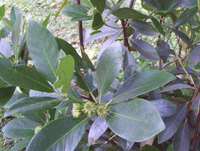
Star anise is the unusual fruit of a small oriental tree. It is, as the name suggests, star shaped, radiating between five and ten pointed boat-shaped sections, about eight on average. These hard sections are seed pods. Tough skinned and rust coloured, they measure up to 3cm (1-1/4”) long. The fruit is picked before it can ripen, and dried. The stars are available whole, or ground to a red-brown powder.
Bouquet: Powerful and liquorice-like, more pungent and stronger than anise.
Flavour: Evocative of a bitter aniseed, of which flavour star anise is a harsher version. Nervertheless, the use of star anise ensures an authentic touch in the preparation of certain Chinese dishes.
Star anise is used in the East as aniseed is in the West. Apart from its use in sweetmeats and confectionery, where sweeteners must be added, it contributes to meat and poultry dishes, combining especially well with pork and duck. In Chinese red cooking, where the ingredients are simmered for a lengthy period in dark soy sauce, star anise is nearly always added to beef and chicken dishes. Chinese stocks and soups very often contain the spice.. It flavours marbled eggs, a decorative Chinese hors d’oeuvre or snack. Mandarins with jaded palates chew the whole dried fruit habitually as a post-prandial digestant and breath sweetener - an oriental comfit. In the West, star anise is added in fruit compotes and jams, and in the manufacture of anise-flavoured liqueurs, the best known being anisette. It is an ingredient of the mixture known as “Chinese Five Spices”.
Like anise, star anise has carminative, stomachic, stimulant and diuretic properties. In the East it is used to combat colic and rheumatism. It is a common flavouring for medicinal teas, cough mixtures and pastilles.
Bouquet: Powerful and liquorice-like, more pungent and stronger than anise.
Flavour: Evocative of a bitter aniseed, of which flavour star anise is a harsher version. Nervertheless, the use of star anise ensures an authentic touch in the preparation of certain Chinese dishes.
Star anise is used in the East as aniseed is in the West. Apart from its use in sweetmeats and confectionery, where sweeteners must be added, it contributes to meat and poultry dishes, combining especially well with pork and duck. In Chinese red cooking, where the ingredients are simmered for a lengthy period in dark soy sauce, star anise is nearly always added to beef and chicken dishes. Chinese stocks and soups very often contain the spice.. It flavours marbled eggs, a decorative Chinese hors d’oeuvre or snack. Mandarins with jaded palates chew the whole dried fruit habitually as a post-prandial digestant and breath sweetener - an oriental comfit. In the West, star anise is added in fruit compotes and jams, and in the manufacture of anise-flavoured liqueurs, the best known being anisette. It is an ingredient of the mixture known as “Chinese Five Spices”.
Like anise, star anise has carminative, stomachic, stimulant and diuretic properties. In the East it is used to combat colic and rheumatism. It is a common flavouring for medicinal teas, cough mixtures and pastilles.